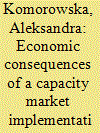| Srl | Item |
| 1 |
ID:
176859


|
|
|
|
|
| Summary/Abstract |
This paper investigates the potential economic consequences of setting up a capacity market in Poland. A computable model of the Polish power generation system is developed and employed to analyse the impact of this mechanism. Two scenarios are designed for this study: (i) a reference scenario that reflects the energy-only market and (ii) a capacity market scenario that assumes the implementation of such an instrument. To assess the economic consequences, the following parameters are estimated: (i) annual electricity prices, (ii) Loss Of Load Hours, (iii) Expected Energy Not Served, and only for the capacity market scenario: (iv) market clearing price, (v) total budget of the capacity market, and (vi) increase in electricity price due to the introduction of the capacity market. The findings of the study indicate that the long-term maintenance of the energy-only market results in higher electricity prices when compared to putting a capacity market into operation. Introducing a capacity market enables existing resources to be used effectively without excessive capital expenditure. The methods and conclusions presented in this paper provide valuable findings and policy insights regarding the potential economic consequences of a capacity mechanism in a power system mostly dominated by coal and undergoing an energy transition.
|
|
|
|
|
|
|
|
|
|
|
|
|
|
|
|
| 2 |
ID:
150747


|
|
|
|
|
| Summary/Abstract |
The article employs qualitative methods in contextualizing and conceptualizing the hybrid renewable energy support policy. It claims that hybrid policies may combine distinct mechanisms to drive desirable objectives better than traditional policies. A policy cycle helps to frame the United Kingdom's Contracts for Difference and Capacity Market (CFD & CM) scheme as a case study. The CFD & CM policy emerged to address environmental and energy challenges through the deployment of renewable energy (RE) in a low-carbon economy, employing liberalization: Environmental protection is foremost in this scheme. The policy combines and improves on the elements of feed-in tariff (FIT) and quota obligation (QO), and strives to solve the problems of these traditional policies. It addresses regulatory uncertainty under FIT by employing private law mechanics to guarantee above-loss reward for low carbon generation, and addresses market uncertainty under QO by incentivizing the capacity to supply future low carbon energy based on projected demand, hence creating a predictable and stable market. It also accommodates other important commitments. Overall, the CFD & CM scheme is a hybrid policy that engages the energy market mainly for advancing the end goal of environmental protection. To thrive however, it needs to meet private sector interests substantially.
|
|
|
|
|
|
|
|
|
|
|
|
|
|
|
|
| 3 |
ID:
176098


|
|
|
|
|
| Summary/Abstract |
The UK's transition to a zero-carbon economy is inevitably leading to an electricity grid with a high penetration of intermittent renewable energy generation, resulting in the need to install grid-scale energy storage systems at an accelerating rate. This study has taken the perspective of a business owner to assess the profitability of deploying battery technologies in the UK electricity market by analysing arbitrage in electricity markets, capacity market auctions, and ancillary services (frequency response and reserve). Additional work was conducted for integrating battery arbitrage cycling with solar and wind generation, comparing the utilisation of a linear programming model against a simplistic threshold cycling model. An overall economic assessment of value streams found that the lowest payback periods for premium ancillary services were 3.3 years (advanced lead-acid battery providing fast reserve) and 6.6 years (lithium-ion battery providing frequency response). Moreover, this research has demonstrated promising returns on investment for stacking short-term operating reserve with arbitrage in the balancing market. In the near future, battery systems will likely attain accelerated deployment due to reforms in ancillary service structures, cost reductions in battery technologies, greater price volatility in the balancing market, and effective policy incentives introduced by the UK government.
|
|
|
|
|
|
|
|
|
|
|
|
|
|
|
|